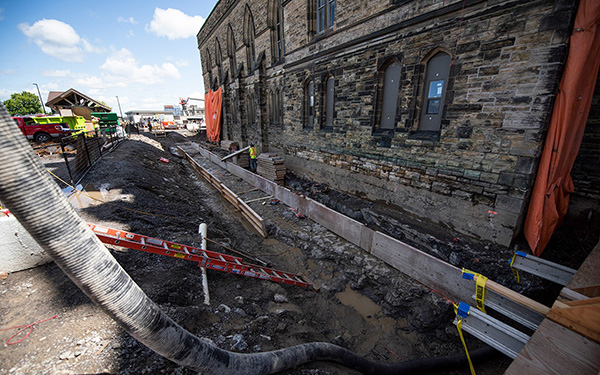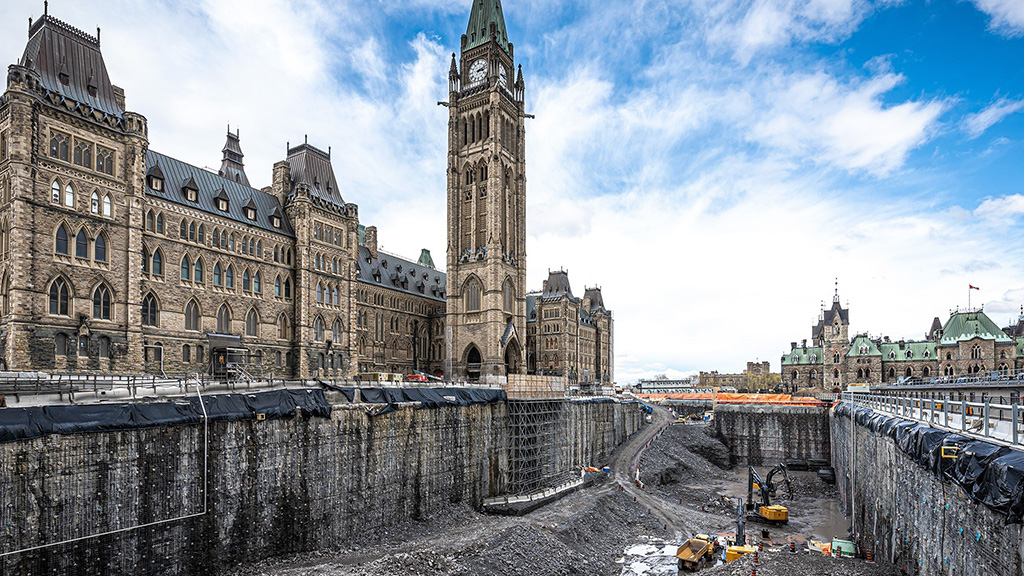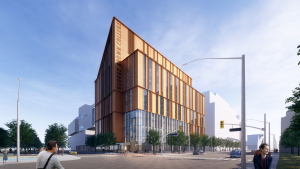The eyes of Ottawa will remain on Parliament Hill in 2024 as the $5-billion Centre Block rehabilitation project moves into its next phase.
The restoration and modernization of the Gothic Revival structure, including construction of a new interconnected three-storey building underground that will house a new Parliament Welcome Centre, represents the largest heritage rehabilitation ever seen in Canada.
Work on the first of multiple phases began in 2018 and completion is still six or seven years away — targeted for 2030 or 2031.
Construction management is a joint venture by PCL and EllisDon.
Each of the phases of work represents an epic project in itself — from the overhaul of the mechanical and electrical systems and restoration of the masonry and stone exterior, to creation of an independent ground plate that will mitigate against seismic activity and a massive asbestos removal program.
As might be expected, project oversight under Public Services and Procurement Canada (PSPC) is complex.
Even Canada’s Senate has a role to play through its Subcommittee on Long Term Vision and Plan, working in parallel with an ad hoc House of Commons subcommittee.
Alberta Senator Scott Tannas is chair of the Senate subcommittee. He says besides offering regular input, the committee has also made important strategic contributions including offering guidance on Indigenous participation, advising on security, consulting on the streamlining of the approvals process and giving input on the configuration of the expanded underground tunnel system.
“It’s not been done before,” said Tannas of the challenging role assigned to the Senate subcommittee.

“We’re trying to make sure that we’re adding value. It’d be so easy for the committee itself to become political. We are very much working hard to avoid that.”
Tannas said the Centre Block and Parliament Hill are symbols of democracy in Canada and will continue to be for hundreds of years, so the building has to be maintained and modernized.
The Centre Block had aging water pipes, crumbling mortar and damaged sculptures and stained glass, and its building performance was woefully inefficient.
PSPC knew it had to make Centre Block more earthquake proof, the electrical system was primitive, and the 2014 attack of a lone gunman focused the government’s attention on the need to address security concerns.
“The gunman changed everything on the Hill for us, and so security and how to incorporate security without making it a fortress,” said Tannas. “Today there are roughly 600,000 people going through there. What will it be like when our population is double? And trying to strike all those balances and deal with the emerging technologies around security.”
Federal auditor general Karen Hogan reported last March that the decision-making process was fragmented which could lead to construction delays. The finding led to streamlining of the flow of information and decision-making, Tannas said.
“She made some good recommendations I thought around better communications between us and PSPC, particularly when we disagreed,” said Tannas.
Early on the Senate subcommittee disagreed with one proposal for temporarily housing the Senate during construction, suggesting as an alternative that the body move temporarily to the former train station across the street after renovations to that building. That structure would then be suited to become a “beautiful government conference centre,” said Tannas.
“That decision saved a couple of hundred million bucks and helped advance some aspects of the construction schedule.”
The latest quarterly update on the project reported that as of Dec. 15, teams have drilled 73 of 92 wells as part of a geo-exchange system attached to the new Parliament Welcome Centre. Each well is 260 metres deep.
As well, the work to restore and repair the Centre Block’s exterior masonry is advancing with stonemasons working on the east and west facades. That program is 14 per cent complete.
Demolition and abatement inside the Centre Block is now substantially complete. About 12 million kilograms of hazardous materials were removed.
This winter crews will install 50 per cent of the temporary posts to support the Centre Block during excavation work, and design work for the Centre Block should also reach the 50-per-cent mark.
Design will also begin on temporary shoring that will support the structure during the rebuild.
Spring milestones will include the launch of the contracting process for the Centre Block’s replica windows, completion of temporary concrete shear walls to support the Centre Block during excavation and the achievement of about 25 per cent of concrete slab rebuilding of the project’s level one.
Tannas will be retired from the Senate by the time the rebuild is complete.
“I’m looking forward to coming back to Parliament and seeing it all in place and ready to work for the next 100 years for Canadians,” he said.
Follow the author on Twitter @DonWall_DCN











Recent Comments